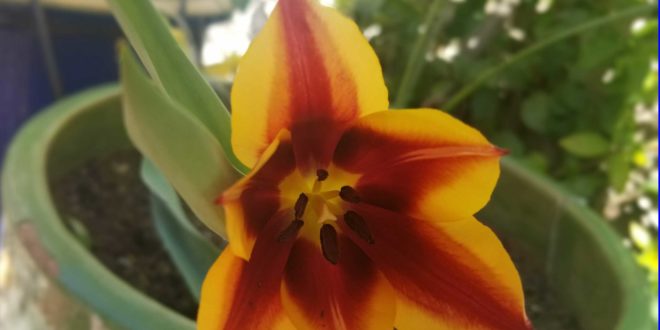Spring in our Sunnyvale garden always has tulips. The majority are the Dutch cultivars and hybrids: Usually large, showy and brightly colored, generally red, pink, yellow, or white. But in the last few years we have included Wild Tulips which are the predecessor species. Tulips originally were found in a band stretching from Southern Europe to Central Asia, but since the seventeenth century have become widely naturalized and cultivated. In their natural state they are adapted to steppes and mountainous areas with temperate climates. Flowering in the spring, they become dormant in the summer once the flowers and leaves die back, emerging above ground as a shoot from the underground bulb in early spring.
The tulip is a member of the lily family, Liliaceae, along with 14 other genera. There are about 75 species, and these are divided among four subgenera. The name “tulip” is thought to be derived from a Persian word for turban, which it may have been thought to resemble.
While tulips had probably been cultivated in Persia from the tenth century, they did not come to the attention of the West until the sixteenth century, when Western diplomats to the Ottoman court observed and reported on them. They were rapidly introduced into Europe and became a frenzied commodity during Tulip mania. Tulips were frequently depicted in Dutch Golden Age paintings, and have become associated with the Netherlands, the major producer for world markets, ever since. In the seventeenth century Netherlands, during the time of the Tulip mania, an infection of tulip bulbs by the tulip breaking virus created variegated patterns in the tulip flowers that were much admired and valued. While truly broken tulips do not exist anymore, the closest available specimens today are part of the group known as the Rembrandts – so named because Rembrandt painted some of the most admired breaks of his time.
Science Stuff
Tulips (Tulipa) form a genus of spring-blooming perennial herbaceous bulbiferous geophytes (having bulbs as storage organs). They often have a different colored blotch at the base of the tepals (petals and sepals, collectively), internally. Because of a degree of variability within the populations, and a long history of cultivation, classification has been complex and controversial.
Flowers: The tulip’s flowers are usually large and are actinomorphic (radially symmetric) and hermaphrodite (contain both male (androecium) and female (gynoecium) characteristics), generally erect, or more rarely pendulous, and are arranged more usually as a single terminal flower, or when pluriflor as two to three (e.g. Tulipa turkestanica), but up to four, flowers on the end of a floriferous stem (scape), which is single arising from amongst the basal leaf rosette. In structure, the flower is generally cup or star shaped. As with other members of Liliaceae the perianth is undifferentiated (perigonium) and biseriate (two whorled), formed from six free (i.e. apotepalous) caducous tepals arranged into two separate whorls of three parts (trimerous) each. The two whorls represent three petals and three sepals but are termed tepals because they are nearly identical. The tepals are usually petaloid (petal like), being brightly colored, but each whorl may be different, or have different colored blotches at their bases, forming darker coloration on the interior surface. The inner petals have a small, delicate cleft at the top, while the sturdier outer ones form uninterrupted ovals. Tulip flowers come in a wide variety of colors, except pure blue (several tulips with “blue” in the name have a faint violet hue), nd have absent nectaries. Tulip flowers are generally bereft of scent and are the coolest of floral characters. The Dutch regarded this lack of scent as a virtue, as it demonstrates the flower’s chasteness.
Androecium: The flowers have six distinct, basifixed introrse stamens arranged in two whorls of three, which vary in length and may be glabrous or hairy. The filaments are shorter than the tepals and dilated towards their base.
Gynoecium: The style is short or absent and each stigma has three distinct lobes, and the ovaries are superior, with three chambers.
Fruit: The tulip’s fruit is a globose or ellipsoid capsule with a leathery covering and an ellipsoid to globe shape. Each capsule contains numerous flat, disc-shaped seeds in two rows per chamber. These light to dark brown seeds have very thin seed coats and endosperm that does not normally fill the entire seed.
Leaves: Tulip stems have few leaves. Larger species tend to have multiple leaves. Plants typically have two to six leaves, some species up to 12. The tulip’s leaf is cauline (born on a stem), strap-shaped, with a waxy coating, and the leaves are alternate (alternately arranged on the stem), diminishing in size the further up the stem. These fleshy blades are often bluish-green in color. The bulbs are truncated basally and elongated towards the apex. They are covered by a protective tunic (tunicate) which can be glabrous or hairy inside.








